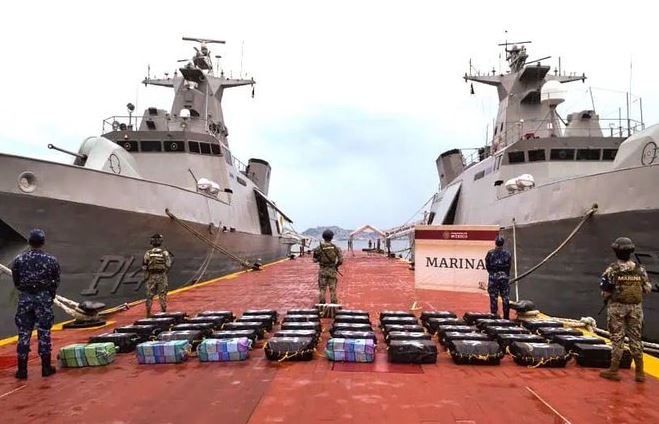In a significant blow to drug trafficking operations, the Mexican Navy has seized 7.2 tons of cocaine in two dramatic raids in the Pacific Ocean. The first operation took place near Manzanillo, where 5.6 tons of cocaine were confiscated from three speedboats. Fifteen suspects were arrested during the high-stakes mission.
In a separate raid near Lázaro Cárdenas, authorities recovered 1.6 tons of cocaine found floating in the water, with an abandoned speedboat discovered nearby. These operations occur amidst escalating cartel violence in Michoacán state, where recent attacks are believed to be linked to ongoing battles for control of coastal drug routes.
Also Read: Risk of Nuclear Accident Looms at Kursk Plant, Warns IAEA Chief
The seizures underscore Mexico’s ongoing efforts to combat drug trafficking, following last year’s high-profile interception of a “narco sub” carrying 7,000 pounds of cocaine. In response to these operations, Mexican authorities have increased surveillance along the Pacific coast, deploying additional naval units to deter further smuggling attempts. The Mexican government reaffirmed its commitment to disrupting the operations of drug cartels, which have long used these waters as key transit routes for narcotics destined for the United States and beyond.
Experts suggest that these successful operations could lead to retaliatory violence from cartels, as the loss of such large quantities of drugs represents a significant financial hit. The Navy’s actions are likely to intensify the ongoing conflict between government forces and organized crime in the region. This latest victory in the fight against drug trafficking highlights the persistent challenges Mexico faces in curbing the influence of powerful cartels, despite continued efforts by law enforcement and the military.
Key Points
- Massive Cocaine Seizure: The Mexican Navy seized 7.2 tons of cocaine in two separate operations in the Pacific Ocean.
- Manzanillo Operation: 5.6 tons of cocaine were confiscated from three speedboats, resulting in the arrest of 15 suspects.
- Lázaro Cárdenas Operation: 1.6 tons of cocaine were recovered floating in the water near an abandoned speedboat.
- Context of Cartel Violence: The seizures occurred amid escalating cartel violence in Michoacán, linked to battles for control of coastal drug routes.
- Increased Security Measures: Mexican authorities have ramped up surveillance along the Pacific coast, deploying additional naval units.
- Potential Retaliation: The seizures may provoke retaliatory violence from cartels, as the loss represents a significant financial hit.
- Ongoing Anti-Trafficking Efforts: The operations highlight Mexico’s continued efforts to combat drug trafficking, following last year’s interception of a “narco sub” carrying 7,000 pounds of cocaine.
Mexico’s cocaine issue is a significant part of the broader drug trafficking problem that has plagued the country for decades. Here are some key aspects of the issue:
1. Role in Global Cocaine Trade
- Mexico is a major transit country for cocaine, with much of the supply originating from South American countries like Colombia, Peru, and Bolivia. The cocaine is typically transported through Mexico to the United States, the largest consumer market, and to Europe and other regions.
2. Cartel Involvement
- Powerful drug cartels, such as the Sinaloa Cartel, Jalisco New Generation Cartel (CJNG), and others, are deeply involved in the cocaine trade. These organizations manage complex networks that include production, transportation, and distribution. Their involvement in the cocaine trade is a major source of income, fueling violence and corruption.
3. Violence and Corruption
- The competition between cartels for control of key trafficking routes, known as “plazas,” often results in extreme violence. This violence extends to confrontations with law enforcement, rival cartels, and even innocent civilians. Corruption within law enforcement and government institutions further exacerbates the problem, making it challenging to effectively combat the cartels.
4. Maritime Trafficking
- A significant portion of cocaine trafficking occurs via maritime routes, particularly along Mexico’s Pacific coast. Drug shipments are often transported on speedboats, fishing vessels, and even semi-submersible “narco subs.” The Mexican Navy has been actively involved in intercepting these shipments, but the vast coastline makes complete enforcement difficult.
5. Economic Impact
- The drug trade, including cocaine trafficking, has a profound economic impact on Mexico. While it generates enormous illicit revenue for cartels, it also undermines legitimate economic activities, increases the cost of law enforcement, and creates a climate of fear that can stifle investment and tourism in affected areas.
6. International Cooperation
- Mexico collaborates with international partners, particularly the United States, to combat cocaine trafficking. This includes intelligence sharing, joint operations, and financial aid aimed at strengthening Mexico’s law enforcement capabilities. However, the effectiveness of these efforts is often limited by corruption and the sheer scale of the drug trade.
7. Societal Impact
- The widespread availability of cocaine and other drugs in Mexico has led to public health issues, including addiction and related social problems. The drug trade also destabilizes communities, as violence and cartel influence erode social cohesion and trust in government institutions.
8. Government Response
- The Mexican government has implemented various strategies to combat cocaine trafficking, ranging from military-led crackdowns on cartels to efforts at reducing demand and addressing the root causes of drug-related violence. Despite these efforts, the cocaine issue remains a persistent challenge, deeply intertwined with broader issues of organized crime, corruption, and socio-economic inequality in Mexico.



